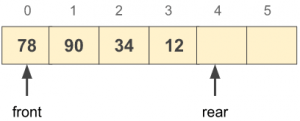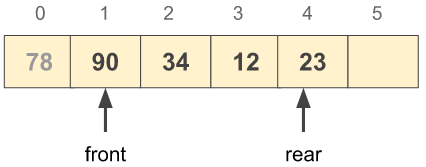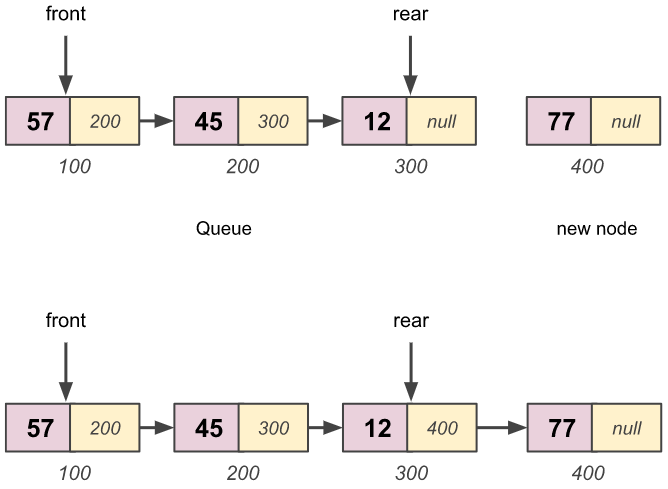Write a Queue Program in C to implement the queue data structure and display the queue using array and linked list.
The Queue is a linear data structure that follows the FIFO pattern in which the element inserted first at the queue will be removed first.
There are real-world examples of queues, the ticket row for trains, customers waiting in a row, etc.
Here is the FIFO representation of the queue.

1. To implement the queue we will follow the FIFO principle.
2. We have to keep track of the front and rear pointers of the queue so that we can do the operations enqueue and dequeue.
3. In enqueue operation, we need to keep incrementing the rear while in dequeue the front will be incremented.
Basic Queue Operations:
- Enqueue: Elements are added at the end of queue.
- Dequeue: Removes the element from the beginning of the queue.
- isEmpty(): Check if the queue is empty or not.
- isFull(): Check if the queue is full or not.
- Peek(): Bring the item to the top of the queue without removing it.
Here, we will implement the queue using two methods:
In this implementation, we are using a structure in which an array of integers is taken. There are two other variables front and rear which are used to store the array index for dequeue and enqueue respectively.
Initially front and rear have value -1 which means that the queue is empty. On enqueue operation, the rear will be moved by one index forward and the data will be inserted at that index. On dequeue operation, we will store the value at the front index and move the front ahead and then return the stored value.
Let’s see the array implementation of the queue data structure using the C programming language.
Here is the array-based implementation of the queue data structure. The C program is successfully compiled and run on a Linux system. The program output is also shown below.
/** C program to implement queues using array*/#include<stdio.h>#define SIZE 3//queue structurestruct queue{int values[SIZE];
int front;
int rear;
};
void enqueue(int);
int dequeue();
int isEmpty();
int isFull();
void display();
//globstruct queue q;
int main()
{q.front = -1;
q.rear = -1;
int user_choice, data;
char user_active = 'Y';
while (user_active == 'Y' || user_active == 'y')
{printf("\n--------Queue Program------\n");
printf("\n1. Enqueue");
printf("\n2. Dequeue");
printf("\n3. Display");
printf("\n4. Exit");
printf("\n\nEnter your choice: ");
scanf("%d", &user_choice);
switch(user_choice)
{case 1:
printf("\nEnter Data: ");
scanf("%d", &data);
enqueue(data);
break;
case 2:
if (!isEmpty())
{data = dequeue();
printf("\n* %d was removed!\n", data);
}else{printf("\nQueue is Empty!\n");
}break;
case 3:
display();
printf("\n");
break;
case 4:
printf("\n\tProgram was terminated!\n\n");
return 1;
default:
printf("\n\tInvalid Choice\n");
}printf("\nDo You want to continue? ");
fflush(stdin);
scanf(" %c", &user_active);
}return 0;
}int isEmpty()
{if (q.front == -1 || q.front > q.rear)
{return 1;
}return 0;
}int isFull()
{if (q.rear == SIZE - 1)
{return 1;
}return 0;
}void enqueue(int data)
{if (isFull())
{printf("\nQueue is Full!\n");
return;
}if (isEmpty())
{q.front += 1;
}q.rear += 1;
q.values[q.rear] = data;
printf("\n* %d was inserted!\n", data);
}int dequeue()
{if (!isEmpty())
{int data = q.values[q.front];
q.front += 1;
return data;
}}void display()
{if (isEmpty())
{printf("\nQueue is Empty\n");
return;
}printf("\n");
int begin = q.front;
while (begin <= q.rear)
{printf("%d ", q.values[begin]);
begin += 1;
}}
Let’s discuss the main functions of the program in detail with examples and their complexities.
Enqueue is the operation to insert the new item to the queue from the rear. To perform the enqueue operation, we need to follow the given steps:
- Increment the rear by one.
- Insert the new item at the rear index of the array.
Example: Insert the new element 23 in the given queue. Here, the size of the queue is 6.
Step 1: Rear is incremented by one, and moved from index 3 to 4.

Step 2: Insert the data at rear

Time Complexity: O(1)
It takes constant time to shift the rear and insert new data into the queue. So, the time complexity of queue program is O(1).
Space Complexity: O(1)
Only temporary space is used for inserting a new node into the queue. So, the space complexity of queue program is O(1).
In this case, we are performing the enqueue operation of queue using array.
--------Queue Program------ 1. Enqueue 2. Dequeue 3. Display 4. Exit Enter your choice: 1 Enter Data: 34 * 34 was inserted! Do You want to continue? y --------Queue Program------ 1. Enqueue 2. Dequeue 3. Display 4. Exit Enter your choice: 1 Enter Data: 90 * 90 was inserted! Do You want to continue? y --------Queue Program------ 1. Enqueue 2. Dequeue 3. Display 4. Exit Enter your choice: 1 Enter Data: 12 * 12 was inserted! Do You want to continue? y --------Queue Program------ 1. Enqueue 2. Dequeue 3. Display 4. Exit Enter your choice: 3 34 90 12 Do You want to continue? n
The Dequeue operation is used to remove an item from the front of the queue. To perform the dequeue operation we have to follow the given steps:
- Store the value at the front index in a temporary variable called data.
- Increment the front by one.
- Return the stored value.
Example: Remove an element from the given queue. Here, the front is at index 0 and after performing the dequeue operation, the front will be shifted from index 0 to 1.
Note that the last front value will not be erased after shifting the front.
Step 1: Store the value of front in data

Step 2: Increment the front by one

Time Complexity: O(1)
It takes constant time to shift the front and remove the data from the queue. So, the time complexity is O(1).
Space Complexity: O(1)
Only temporary space is used for inserting a new node into the queue. So, the space complexity is O(1).
In this case, we are performing the dequeue operation of queue using array.
--------Queue Program------
1. Enqueue
2. Dequeue
3. Display
4. Exit
Enter your choice: 3
34 90 12
Do You want to continue? y
--------Queue Program------
1. Enqueue
2. Dequeue
3. Display
4. Exit
Enter your choice: 2
* 34 was removed!
Do You want to continue? y
--------Queue Program------
1. Enqueue
2. Dequeue
3. Display
4. Exit
Enter your choice: 3
90 12
Do You want to continue? y
--------Queue Program------
1. Enqueue
2. Dequeue
3. Display
4. Exit
Enter your choice: 4
Program was terminated!In this approach, we will use the concept of the linked list. We have to create the front and rear pointers to keep track of the queue on dequeue and enqueue operations respectively.
The front and rear pointers will be initialized by NULL. The front pointer will point to the first node and the rear pointer will point to the last node of the queue. On enqueue operation, we have to insert a new node at the end of the list while in dequeue, the first node will be removed from the queue.
Let’s see the linked list implementation of the queue using the C programming language.
Here is the C program implementation of the queue using a linked list. The C program is successfully compiled and run on a Linux system. The program output is also shown below.
/** C program to implement queue using a linked list*/#include<stdio.h>#include<stdlib.h>// structure of a nodestruct node{int data;
struct node* next;
};
// globally declared pointersstruct node* front = NULL;
struct node* rear = NULL;
// function prototypingvoid enqueue(int);
int dequeue();
void display();
struct node* create(int);
int isEmpty();
int main()
{int user_choice, data;
char user_active = 'Y';
while (user_active == 'Y' || user_active == 'y')
{printf("\n--------> Queue Program <------\n");
printf("\n1. Enqueue");
printf("\n2. Dequeue");
printf("\n3. Display");
printf("\n4. Exit");
printf("\n\nEnter your choice: ");
scanf("%d", &user_choice);
switch(user_choice)
{case 1:
printf("\nEnter Data: ");
scanf("%d", &data);
enqueue(data);
break;
case 2:
if (!isEmpty())
{data = dequeue();
printf("\n* %d was removed\n", data);
}else{printf("\nQueue is Empty!\n");
}break;
case 3:
display();
printf("\n");
break;
case 4:
printf("\n\tProgram was Terminated!\n\n");
return 1;
default:
printf("\n\tInvalid Choice\n");
}printf("\nDo You want to continue? ");
fflush(stdin);
scanf(" %c", &user_active);
}return 0;
}// creates a new nodestruct node* create(int data)
{struct node* new_node = (struct node*) malloc (sizeof(struct node));
if (new_node == NULL)
{printf("\n Memory can't be allocated\n");
return NULL;
}new_node->data = data;
new_node->next = NULL;
return new_node;
}// check if the queue is emptyint isEmpty()
{if (front == NULL || rear == NULL)
{return 1;
}return 0;
}// inserts an item to the queuevoid enqueue(int data)
{struct node* new_node = create(data);
if (new_node != NULL)
{// if the queue is emptyif(front == NULL)
{front = new_node;
}else{rear->next = new_node;
}// rear pointing to the new noderear = new_node;
printf("\n* %d was inserted!\n", data);
}}// removes an item to the queueint dequeue()
{if (!isEmpty())
{int data = front->data;
front = front->next;
return data;
}}// display the queuevoid display()
{if (isEmpty())
{printf("\nQueue is Empty!\n");
return;
}printf("\n");
struct node* temp = front;
while (temp != NULL)
{printf("%d ", temp->data);
temp = temp->next;
}}
Let’s discuss the main functions of the program in detail with examples and their complexities.
To perform the enqueue operation, we have to follow the given steps:
- Update the next pointer of the rear node to the new node.
- Update the rear pointer to the new node.
Example: Insert the new node with data 77 at the end of the given queue.
Step 1: Updating the next of the rear node to the new node.

Step 2: Update the rear pointer to the new node.

Time Complexity: O(1)
Updating the rear pointer does take a constant amount of time. So, the time complexity is O(1).
Space Complexity: O(1)
Since using the temporary variables to perform the enqueue operation so space is constant. So, the space complexity is O(1).
In this case, we are performing the dequeue operation of queue using array.
--------> Queue Program <------ 1. Enqueue 2. Dequeue 3. Display 4. Exit Enter your choice: 1 Enter Data: 90 * 90 was inserted! Do You want to continue? y --------> Queue Program <------ 1. Enqueue 2. Dequeue 3. Display 4. Exit Enter your choice: 1 Enter Data: 56 * 56 was inserted! Do You want to continue? y --------> Queue Program <------ 1. Enqueue 2. Dequeue 3. Display 4. Exit Enter your choice: 1 Enter Data: 12 * 12 was inserted! Do You want to continue? y --------> Queue Program <------ 1. Enqueue 2. Dequeue 3. Display 4. Exit Enter your choice: 3 90 56 12 Do You want to continue? n
To perform the dequeue operation we have to follow the given steps:
- Store the value at the front node.
- Move the front node to its next node.
Example: Let’s see an example of the dequeue operation in the given queue.
Step 1: Store the data of the front node.

Step 2: Move the front pointer to next node.

Time Complexity: O(1)
Updating the front pointer does take a constant amount of time. So, the time complexity is O(1).
Space Complexity: O(1)
Since using the temporary variables to perform the dequeue operation, space is constant i.e. O(1).
In this case, we are performing the dequeue operation of queue using linked list.
--------> Queue Program <------
1. Enqueue
2. Dequeue
3. Display
4. Exit
Enter your choice: 3
90 56 12
Do You want to continue? y
--------> Queue Program <------
1. Enqueue
2. Dequeue
3. Display
4. Exit
Enter your choice: 2
* 90 was removed
Do You want to continue? y
--------> Queue Program <------
1. Enqueue
2. Dequeue
3. Display
4. Exit
Enter your choice: 3
56 12
Do You want to continue? y
--------> Queue Program <------
1. Enqueue
2. Dequeue
3. Display
4. Exit
Enter your choice: 4
Program was Terminated!To practice programs on every topic in C, please visit “Programming Examples in C”, “Data Structures in C” and “Algorithms in C”.
If you find any mistake above, kindly email to [email protected]- Check Computer Science Books
- Practice Programming MCQs
- Check Data Structure Books
- Practice Design & Analysis of Algorithms MCQ
- Apply for Computer Science Internship
